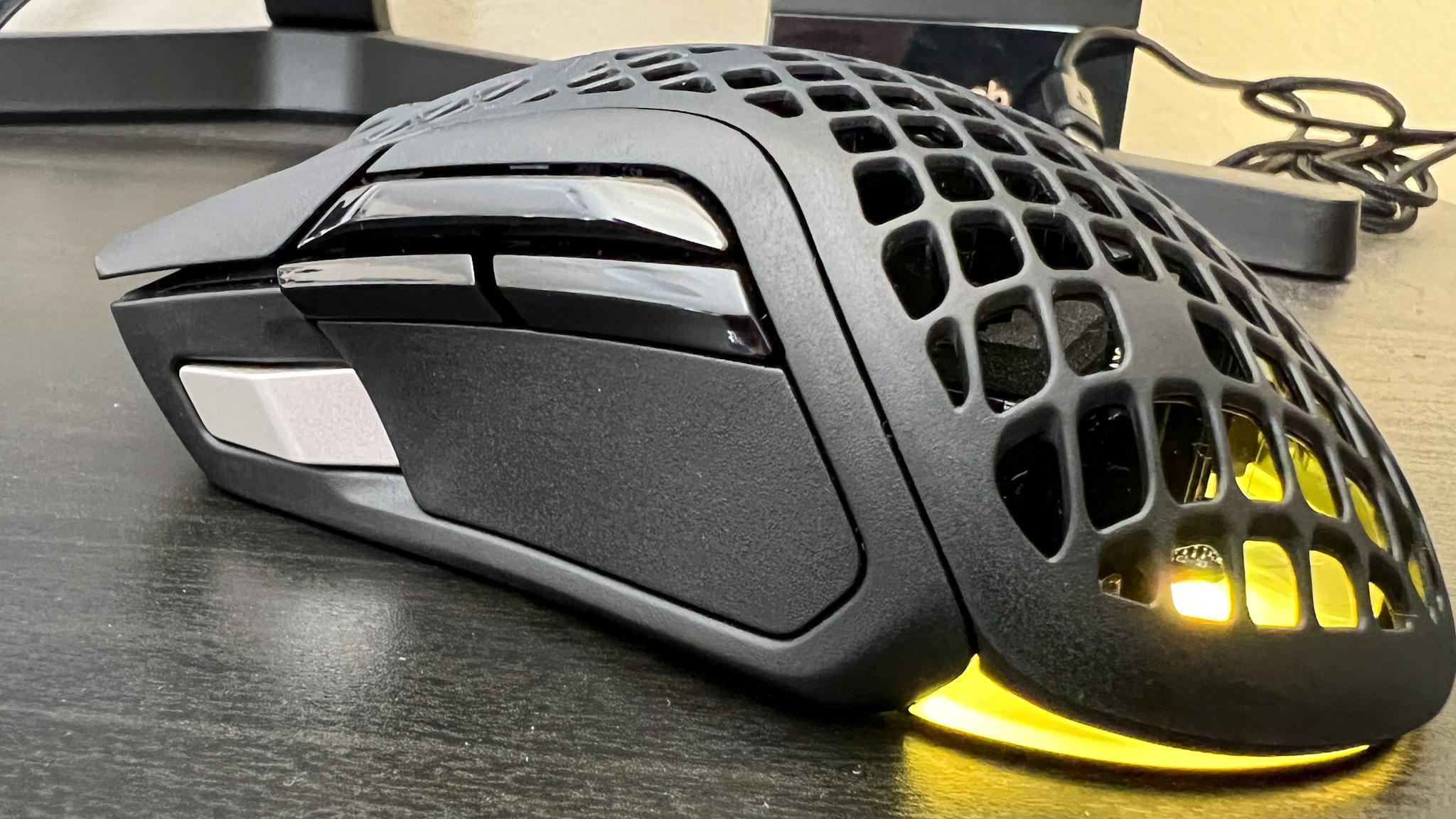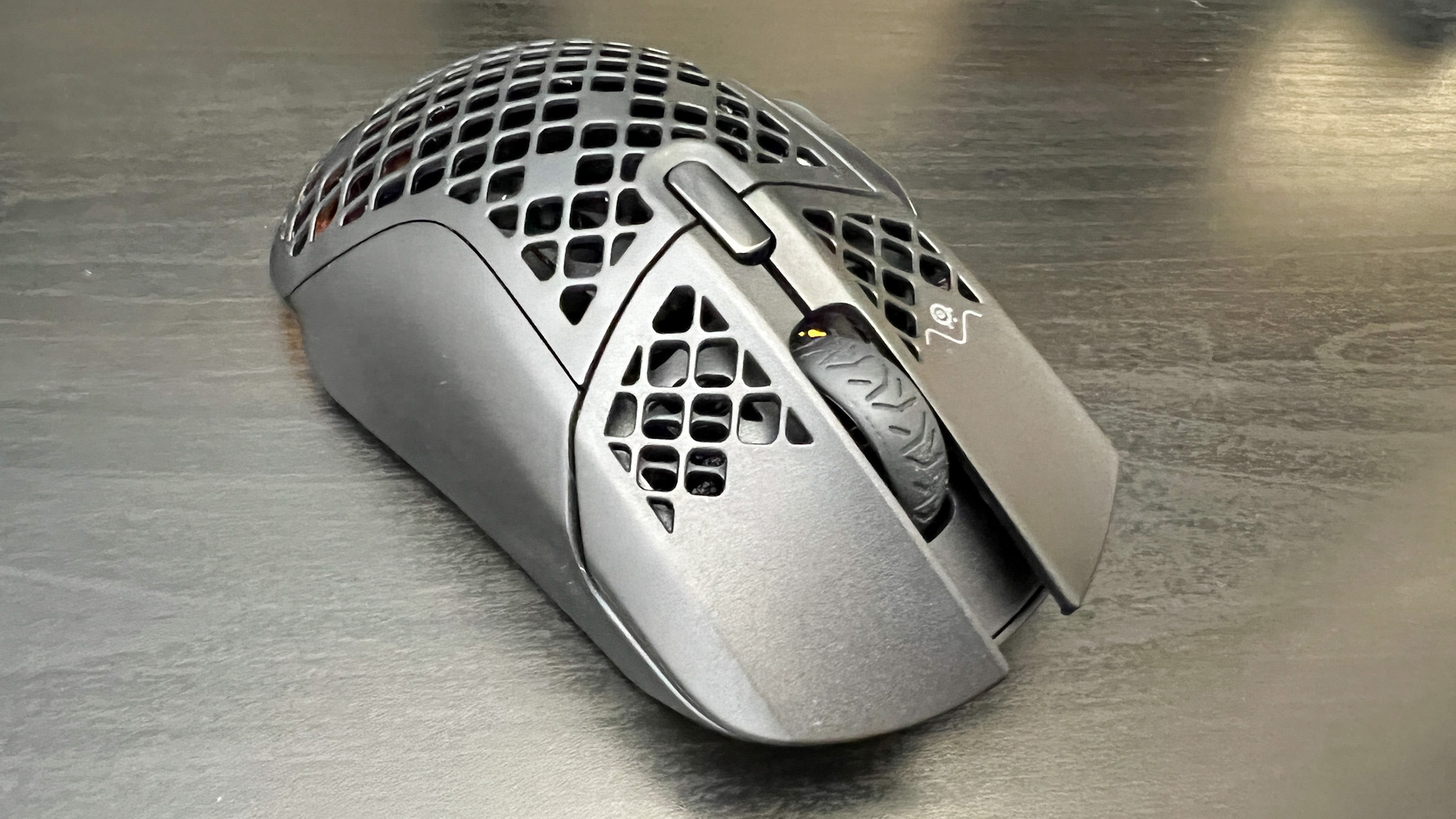GamesRadar+ Verdict
The SteelSeries Aerox 5 isn't aiming for the hands of competitors, but it does an excellent job of keeping everyday players in all their favorite games. Versatile, smooth, and comfortable, this is a solid all-rounder with an excellent battery life to boot. While some design frustrations dampen the experience in certain genres, there's enough going on under the hood here to keep everyone happy.
Pros
- +
Comfortable shape, even with honeycomb design
- +
Long-lasting battery life
- +
Fast, reliable sensor
- +
Smooth feet
Cons
- -
Longer back is a little unwieldy
- -
Some additional buttons are difficult to hit
- -
RGB is hidden during use
Why you can trust GamesRadar+
The SteelSeries Aerox 5 Wireless has wiggled its way into the market as a mid-range, lightweight jack of all trades. At $139.99 / £129.99, the wireless model is pitching at a new price point - this is the second most expensive SteelSeries mouse to date (save for the Aerox 9 Wireless, released at the same time for $10 more). While the Aerox 9 has its sights firmly set on the MMO / MOBA market, though, the SteelSeries Aerox 5 aims to offer far more flexibility at that high price point.
Both the SteelSeries Aerox 5 Wireless and a cheaper ($79.99 / £79.99) wired model hit the shelves at the same time. I've been putting both through their paces here, though the experience is largely the same between the two models, to see just how the latest wave of honeycomb pointers fares against the best gaming mouse options on the market.
Design

Price: $139.99 / £129.99 (wireless) | $79.99 / £79.99 (wired)
Form factor: Right-handed
DPI: 18,000
IPS: Up to 400
Switches: SteelSeries mechanical switches
Connectivity: Wired / Wireless (2.4GHz / Bluetooth 5.0)
Feet: 100% PTFE
Weight: 74g (wireless) | 66g (wired)
While not immediately noticeable, I quickly found myself navigating around the sheer length of the SteelSeries Aerox 5. This is no small pointer, and while there's no obvious heft at first glance, the longer dome tail and higher buttons quickly make themselves known. There's a comfortable slope to the back here, but one that I felt lasted just a little too long. It caused the butt of the mouse to nestle into the pad of my palm too comfortably, which meant it wasn't as easy to wield around tight spots. That length also means this mouse isn't designed for a fingertip grip.
Of course, as you might expect from that price point everything is moulded together with high-quality materials, leaving a lasting impression of quality here. I particularly appreciated the softer-touch plastic on the honeycomb shell. Honeycomb designs can sometimes feel a little rough on the palms, especially during longer sessions. However, I barely felt the notches in the plastic here and even found them to offer a pleasing sense of grip as well.

There are also three RGB lighting zones to play with here, though the only one visible from the top is a panel of light running underneath the back end of the mouse. While nice to have, I largely ignored RGB settings during play - I couldn't see the effect once my hand was sitting on top of the mouse and I valued the battery life much more.
Features
The SteelSeries Aerox 5 feels a little stuck in the middle when it comes to its marketing as a lightweight device. This is still a nippy wireless gaming mouse at 74g, but that's just a little too heavy to be considered a feature in itself in today's market. The Roccat Burst Pro Air manages a wireless connection with a 68g weight, for $99.99 no less, and the new Razer Viper V2 Pro squeezes itself down to 58g for just $10 / £10 more than the Aerox 5 Wireless. Still, the wired model comes significantly closer to that lightweight dream - at just 66g it's by far the better option for those after an FPS-only pointer.
Of course, this isn't a tank like the Logitech G502 Lightspeed Wireless (114g) or the wired Razer Basilisk V3 (101g), but for a pointer marketing itself as an "ultra lightweight wireless gaming mouse", there's plenty of room for improvement.
That's not necessarily a bad thing, though. I play a variety of different games, all depending on where my mood takes me, so keeping a featherlight pointer as a permanent fixture on my desk just doesn't make sense. And that's where the SteelSeries Aerox 5 shines. This, of course, isn't going to become an fps competitor's best friend, but it doesn't want to be. Instead, there's a solid feel here, with four side buttons to tinker with, speedy USB-C charging, a lengthy battery life, and buttery smooth feet.

You can connect via a 2.4GHz USB-C or USB-A connection (swapped using a handy adapter on the charging cable), and I only needed to juice this pointer up a couple of times during my whole two weeks of testing. Thanks to a fast-charging connection, even this charging period was painless - I generally only needed half an hour or so on the wire before running for hours tether-free.
All of that comes with a robust selection of additional macro options; two traditional side buttons, an up/down rocker sitting above them, and a DPI-shifting sniper button located towards the front of the mouse. As we'll see in just a moment, I did struggle to find much value in the latter two, however.
Performance
The SteelSeries Aerox 5 is designed as a companion to your whole Steam library, rather than focusing on one genre in particular. However, my first port of call was still Apex Legends, where I was impressed with the responsive feel of the SteelSeries mechanical switches under each main click, and the accuracy of the TrueMove Air sensor. Wrap all of that up with incredibly smooth PTFE feet (seriously, this thing feels like it's floating on air, even over the most textured of surfaces), and I don't think anyone would feel disappointed with the core performance on offer here. I was gliding that camera across the battlefield and even managed to fly gracefully through Control's labyrinths (something I still struggle with on mouse and keyboard).

The two standard macro buttons were well placed for all manner of programmed actions during these faster titles, but I did struggle to reach the sniper button and accurately deploy the up / down rocker. My smaller hands just weren't able to shimmy up the mouse fast enough to hold the temporary DPI drop during critical moments, and I often lost control as a result. It's likely that even with larger hands this manoeuvre would still be difficult, as I was completely repositioning my hand to be able to reach.
The rocker was unusable when the pressure was on. Situated just above the standard two-button array, I could never find the purchase necessary to switch this button upwards comfortable during gameplay - I always seemed to glide over it before actually actuating the button itself. Similarly, it's just too heavy to reliably hit downwards during faster action sequences either. That's more a frustration with an additional extra, though - there's nothing forcing you to use such a button and I did find it usable in slower strategy games like Cities Skylines and Planet Coaster.

I was impressed, however, with the click feel. While a little heavier than traditional FPS-style mice, I was relieved to not have every thought immediately clicked through onto the battlefield. There was a greater sense of precision here compared with the super light touches of the likes of the Razer Viper V2 Pro and Corsair M65 RGB Ultra, though one that didn't hurt reaction times.
Should you buy the SteelSeries Aerox 5 Wireless?

If you're after an all-round gaming mouse that will serve up the speed and precision required for casual FPS play, the comfort for long strategy and simulation sessions, and the macros for weekend MOBA / MMO play, then the SteelSeries Aerox 5 Wireless does a fine job of ticking all your boxes. However, we'd recommend the vast majority of players start their search with the wired model for the best value for money. This isn't a cheap gaming mouse, but the wired model's list price is substantially lower, and still provides the same core experience (all with a lighter form factor to boot). However, if you're looking for a cable-free setup, there's excellent flexibility in both your connection and charging here - and an impressive battery life to boot.
Of course, there are some design frustrations that reared their heads during my own testing. The up / down paddle rocker simply doesn't perform to its fullest potential, and the sniper button is placed too far up the pointer for smaller hands to reach. If you're looking for a more macro-friendly wireless mouse, I'd recommend the Logitech G502 Lightspeed if you don't mind adding a little extra weight, or the SteelSeries Aerox 9 Wireless if you still want to keep this form factor.
For a true lightweight gaming mouse, however, the Roccat Burst Pro Air has just stormed onto the scene, offering a smaller footprint, 68g weight, and lower starting price as well.
How we tested the SteelSeries Aerox 5 Wireless
I used the SteelSeries Aerox 5 Wireless as my main mouse for two weeks, while also comparing my experiences to the wired version as well. During this time, the Aerox 5 was used for all work and play and tested specifically using Apex Legends, Control, Shadow of the Tomb Raider, Cities Skylines, and Planet Coaster. I also used the SteelSeries Aerox 9 Wireless, Logitech G502 Lightspeed Wireless, and Razer Viper V2 Pro as reference points around this price tag as well.
You can find out more about how we test gaming mice and a full guide to all our recommendations in our GamesRadar+ Hardware Policy.
For more of our top picks, check out the best Razer mouse options on the market right now. Or, for a full setup refresh, take a look at the best gaming keyboards and best gaming headsets.

Managing Editor of Hardware at GamesRadar+, I originally landed in hardware at our sister site TechRadar before moving over to GamesRadar. In between, I've written for Tom’s Guide, Wireframe, The Indie Game Website and That Video Game Blog, covering everything from the PS5 launch to the Apple Pencil. Now, i'm focused on Nintendo Switch, gaming laptops (and the keyboards, headsets and mice that come with them), PS5, and trying to find the perfect projector.



